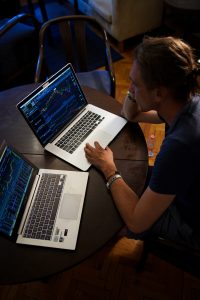Forex trading, also known as foreign exchange trading, is the practice of buying and selling currencies in order to make a profit. It is a global market where traders from all over the world participate, with a daily turnover of over $5 trillion.
The forex market is unique in that it operates 24 hours a day, five days a week, with no central exchange or clearing house. Instead, it is made up of a network of banks, brokers, and traders who communicate with each other electronically. This makes it a highly accessible market for traders of all levels of experience and capital.
One of the key features of forex trading is leverage. This allows traders to control large sums of money with a relatively small amount of capital. For example, a trader with a $1,000 account could control a position of $100,000 using 100:1 leverage. While leverage can amplify profits, it also increases the risk of losses.
Forex trading involves buying one currency and selling another simultaneously. Currencies are quoted in pairs, with the first currency being the base currency and the second currency being the quote currency. The price of a currency pair reflects the exchange rate between the two currencies.
There are different types of orders that traders can use to enter and exit positions in the forex market. The most common order is a market order, which is executed at the best available price. Limit orders are used to enter or exit positions at a specific price level, while stop orders are used to limit losses.
In addition to traditional forex trading, there are also other ways to participate in the forex market. One of these is through the use of forex options, which give traders the right but not the obligation to buy or sell a currency at a specific price on or before a specific date. Another way is through the use of forex futures, which are contracts that obligate the buyer or seller to buy or sell a currency at a specific price on a specific date.
There are many factors that can influence the forex market, including economic indicators, geopolitical events, and central bank decisions. Traders use various analysis techniques to try to predict future market movements, including technical analysis, fundamental analysis, and sentiment analysis.
Technical analysis involves studying price charts to identify patterns and trends that can indicate future price movements. Fundamental analysis involves analyzing economic and political factors that can affect the value of a currency. Sentiment analysis involves studying the opinions and attitudes of other traders and investors in the market.
In order to be successful in forex trading, traders need to have a solid understanding of the market, as well as a disciplined approach to risk management. This involves setting stop-loss and take-profit orders to limit losses and lock in profits, as well as monitoring market conditions and adjusting positions accordingly.
In conclusion, forex trading is an exciting and dynamic market that offers opportunities for traders of all levels of experience and capital. With the right knowledge and approach, traders can potentially achieve significant profits in this global market. However, it is important to approach forex trading with caution and discipline, and to understand the risks involved.






